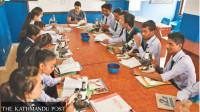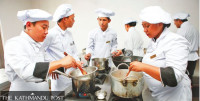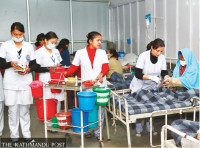Miscellaneous
The discharge of history
Where, after all, did the builders of these monuments that have withstood the test of time, relieve themselves? Can a history of Nepali toilets even be traced?
Marissa Taylor
Finding a half-decent bathroom in Kathmandu, even in places considered touristic hubs, can be a wild-goose chase. With toilets ranging from the disgustingly pungent to those that are outright putrid, many tourists (and locals) will attest that some of their most uncomfortable moments in the Capital have been under the duress of nature’s most urgent call. Even the famed Kathmandu Durbar Square, that boasts one of the highest visitor footfalls in the Valley, is home to only two public bathrooms—and needless to say, they are anything but flattering. If the modern day toilet woes can be pinned onto mismanagement and indifference, it is interesting to note that the immensely historic and cultural spaces like the three Durbar Squares—with their plethora of museums and curated palaces—remain suspiciously mum about its traditional restrooms. Where, after all, did the builders of these monuments that have withstood the test of time, relieve themselves? Can a history of Nepali toilets even be traced? Where would one even start?
Like much of Nepali history, the forbearers of the odorous ‘modern’ toilets too are hard to pin down. The development of water supply projects, and hence modern day plumbing and running water, can be traced back to 1895, with the development of the first piped water supply system, the Bir Dhara network (1891-1893). The system also led to the establishment of Pani Goshowara Adda which provided limited private and community standpipes in a few parts of Kathmandu. The water services then gradually were extended to places like Amalekhgunj, Birgunj, Palpa and Jajarkot. The sector received a fair priority in the First Five Year Development Plan, which started in 1956. The sector activities were placed under the Department of Irrigation for a while until the Department of Water Supply and Sewerage (DWSS) was established in 1972. Initially DWSS was limited to constructing comparatively larger water supply systems in district headquarters and urban centres but it gradually expanded to have a nationwide network to serve all kinds of settlements—urban, semi-urban and rural areas.
Even before the development of the Bir Dhara, the use of traditional hitis or stone spouts intricately connected to underground water channels have been well documented by scholars.The history of the sewage system, however, is far more muddled.

In Hanuman Dhoka, the last remaining evidence of what could possibly be the first indoor-toilets in Nepal still stand, albeit in a state of disrepair. There are two toilets on the first and second floors in the northern building of the Vayu Chowk. The eastern wing of the Hanuman Dhoka, with ten courtyards, is the oldest part of the complex, dated to the mid-16th century. It was believed to have been the living quarters of King Pratap Malla. But the Vayu Chowk, the northern wing of Hanuman Dhoka, is believed to have had the bedrooms of the members of the royal family after Pratap Malla. And the construction of the indoor toilets was done for the convenience of these royal family members.
The toilets on the second floor are believed to have been built during the Malla regime. It has two entrances: one from the outside of the courtyard and one from the third floor.The two toilets, possibly separate for men and women, are 6ft 3 inches tall and 9ft 9 inches wide and have ventilations. The defecation would take place in these two rooms and the faeces would be collected through a four inch hole in the southern end of the roof hole directly into ghyampos (large chamber pots) placed in two small 3ft by 10inch rooms, on the floor below. In the toilet on the first floor there were three toilet pans, all facing north. These are believed to have been built during the Shah era, for easier access. The method of collection of faeces had already been altered as well. Instead of using ghyampos, they had started using copras; copras were smaller in size and more elegant and sizable for royalty.
An individual toilet was also constructed on the third floor of the eastern wing of the old palace when King Rajendra Bikram Shah was put under house arrest. The toilet is still intact, despite the wing suffering heavy damages in last year’s earthquakes. Unfortunately the staircase that led to the second floor toilets in the Vayu Chowk no longer exists; years of reconstruction and renovation have changed the face of many structures, including Vayu Chowk’s. The earthquakes of last year have completely destroyed the Vayu wing as well, making it perilous to step into the building. There is no evidence left in the other two durbar squares of Bhaktapur and Patan of historic toilets. “People have never given much importance to conserving toilets. When we talk about civilisation, waste management is just as crucial; but it is often overlooked. We have all the information on our kings but when it comes to waste management, we have always turned a deaf ear. This is actually a measurement of how civilised our kings were, even back then. They were socially responsible and gave equal importance to privacy,” says Vishnu Raj Karki, former Director General of the Department of Archaeology (DoA).
If these early toilets were a mark of civility, their traces are fast disappearing. Perhaps, they have lost their relevance with time, just as archaeologists of future aeons will surely overlook the hideous Ghumti Sauchalayas (Mobile Bathrooms) that are in vogue today. Yet, these Malla and early Shah-era bathrooms, if not anything else, will provide a quirky detour on your next museum visit. A holistic history, after all, must seek to cobble a larger picture. Even if it is far from flattering, and a little pungent.




 25.56°C Kathmandu
25.56°C Kathmandu










